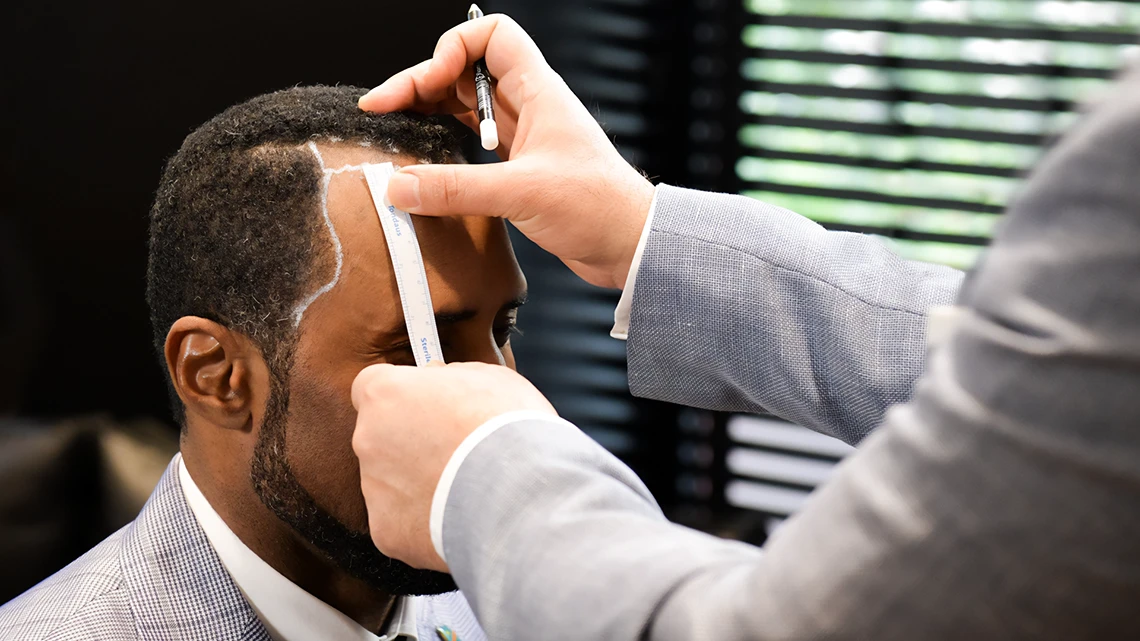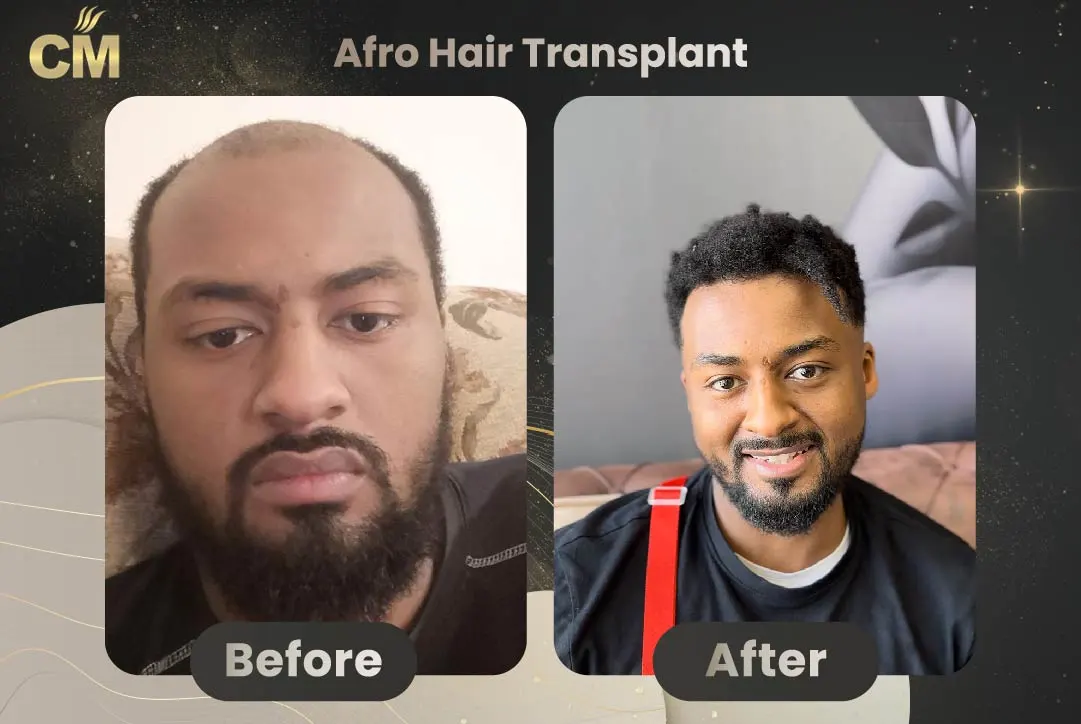Afro-American Hair Transplant in Turkey
Hair loss affects people of all backgrounds, but those with Afro and american textured hair face unique challenges due to the tight curl pattern and coiled follicle structure. These characteristics make transplantation more complex, requiring advanced techniques and experienced surgeons. In recent years, Turkey has become a global hub for Afro hair transplants, offering specialized expertise, modern facilities, and affordable all-inclusive packages. Patients from around the world, especially those with curly and coily hair types, now travel to Istanbul and other Turkish cities to achieve natural, long-lasting results.
What Is Afro Hair Transplant?
An Afro hair transplant is a surgical procedure designed specifically for individuals with tightly curled or coiled hair (Types 4A, 4B, 4C). Unlike straight or wavy hair, Afro and american textured follicles curve beneath the skin, making extraction and implantation more delicate.
The goal of the procedure is to restore hair to areas affected by baldness, thinning, or receding hairlines while preserving the natural curl pattern and achieving density that looks authentic and balanced.

How African Hair Transplant Differs from Other Hair Types
Afro – American textured hair presents unique features that set it apart from other transplant cases:
-
Curly and Fragile Follicles: Coiled grafts are more prone to damage during extraction.
-
Lower Graft Requirement: Each curl covers more surface area, so fewer grafts achieve fuller results.
-
Hairline Design: Afro hairlines often use smaller, zigzag patterns to ensure natural appearance.
-
Implant Angle: Less emphasis is placed on angle precision since curls create natural volume.
-
Post-op Redness: Less noticeable on darker skin tones.
Because of these differences, not all standard techniques are suitable for Afro hair. Only specialized surgeons can deliver safe, natural outcomes.
Best Technique for Afro Hair Transplant
Not all transplant techniques work for Afro hair:
-
DHI (Direct Hair Implantation): Not suitable, as the straight Choi pen needle cannot accommodate coiled follicles. Attempting this may damage grafts and lower survival rates.
-
FUT (Follicular Unit Transplantation): Rarely used because Afro hair is more prone to visible scarring, and strip removal can complicate healing.
-
FUE with Sapphire Blades: The most effective option. Using sapphire blades, surgeons open precise channels before placing grafts one by one. This allows better control of twisted follicles and reduces the risk of transection.
Some clinics also use manual FUE for Afro hair, increasing precision during extraction and protecting grafts. This approach remains the gold standard for ethnic and curly hair transplants in Turkey.
Afro-american Hair Transplant Process
The procedure involves several carefully managed steps:
1. Consultation and Hairline Design
Surgeons evaluate the patient’s curl pattern, scalp condition, donor area, and goals. Personalized hairlines are designed to complement facial features and preserve natural aesthetics.
2. Pre-Treatment Evaluation
Blood tests and allergy checks ensure safety. Afro-textured patients must inform surgeons about existing sensitivities to avoid reactions to gels or medications.
3. Local Anesthesia
Needle-free anesthesia systems are used to minimize discomfort.
4. Extraction of Follicles
Using FUE micro-motors or manual tools, surgeons carefully extract coiled follicles from the donor area (usually the back or sides of the scalp). Because the follicles curve under the skin, careful handling is vital to avoid breakage. Extracted grafts are preserved in HypoThermosol solution, which protects viability better than standard saline.
5. Channel Creation
The surgeon uses sapphire blades to open channels in the recipient area. Blade size is carefully matched to each follicle, ensuring a secure fit and preventing damage.
6. Implantation
Single-hair follicles are placed along the front for a soft edge, while multi-hair grafts are placed behind for density. Placement follows a zigzag pattern, mimicking natural growth.
7. Immediate Aftercare
The scalp is dressed, and patients return the next day for a professional first wash. Some clinics provide PRP therapy to accelerate healing and improve graft survival.
Recovery and Growth Timeline
Patients should expect a structured healing process:
-
Week 1–2: Redness and swelling fade; scabs fall off naturally.
-
Month 1–3: Temporary shedding (shock loss) occurs.
-
Month 4–6: New growth begins as follicles stabilize.
-
Month 6–12: Hair thickens, curl patterns return.
-
Month 12–15: Final results with dense, natural coverage are visible.
During recovery, patients should maintain proper scalp hygiene, avoid tight hairstyles, and follow nutrition recommendations to promote healthy regrowth.
Why Curly and Coily Hair Requires Specialists
Curly and coily hair is more complex to transplant than straight or wavy hair. The follicles grow in curved patterns beneath the skin, which makes them more delicate and increases the risk of breakage during extraction or implantation. To achieve natural, long-lasting results, these hair types require a specialist approach that combines:
-
Experienced Surgeons: Professionals with specific training in ethnic and textured hair restoration.
-
Advanced Techniques: Use of manual FUE, sapphire blades, and precise tools adapted for coiled follicles.
-
Protective Graft Handling: Specialized preservation solutions and careful extraction methods to minimize damage.
-
High Success Rates: When managed by skilled teams, graft survival can exceed 90%, even with tightly curled or fragile follicles.
Afro Hair Transplant Cost in Turkey
Afro hair transplant prices in Turkey are significantly lower than in Western countries. On average, costs range between $2,500 and $5,000, depending on graft count, clinic reputation, and package inclusions.
ClinMedica offers all-inclusive packages covering:
-
Accommodation in 4–5 star hotels
-
Airport and clinic transfers
-
Full medical consultation and tests
-
Procedure with advanced technology
-
Aftercare and follow-up support



